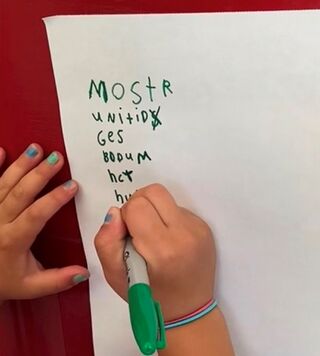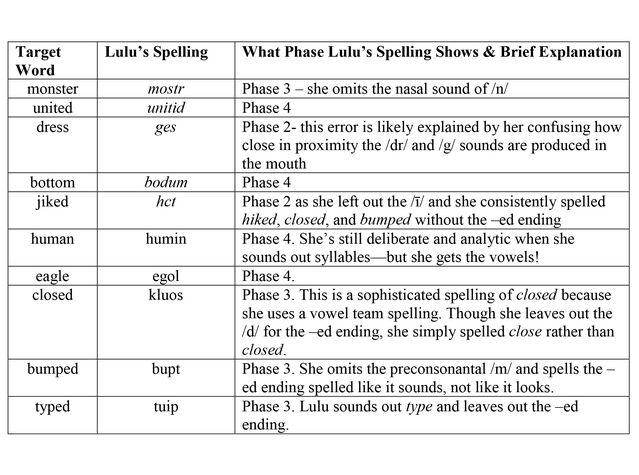Relationships
What Your Kindergartner’s Writing Shows About Reading
Writing and spelling are related to developing reading brain circuitry.
Posted October 4, 2021 Reviewed by Devon Frye
Key points
- Early literacy development happens in five developmental word reading and developmental spelling phases.
- The kindergarten phases are outcomes of developing reading circuitry.
- Kindergarten spellings of novel words can show you what the child knows or does not know on the path to literacy.
For teachers and parents, a close look at a child’s writing sample offers key information about his or her literacy development. In this post, I collaborate with co-author Dr. Molly Ness of Fordham University to show how analysis of writing in children as young as kindergarten shows rich information as outcomes of the child’s brain development and reading circuitry. We focus on how children develop literacy as spellers and how to use the rich evidence from spelling samples to monitor progress and plan for instruction. Our case study of Lulu, a kindergarten speller, will demonstrate what her spelling reveals about how she is thinking about how English writing, reading, and spelling work.
An Overview of Spelling Phases
As children evolve as early readers, they move through a series of five developmental spelling phases, outlined in the table below. These phases reveal how the child integrates—or fails to integrate—phonological awareness, alphabet fluency, letter-sound connections, phonics, sight words knowledge, and use of morphology. The research in support of phase observation and spelling to read spans over five decades (for a comprehensive review of research, see Gentry & Ouellette, 2019)
Learning to spell is not a matter of memorizing words, but an orderly developmental process with a series of increasingly more complex spelling patterns that “culminates in a much greater understanding of English spelling than simple relationships between speech sounds and their graphic representations" (Reported in Lutz, 1986, p. 742). In Lulu’s sample below, you will see how she analyzes each word in a ten-word spelling activity revealing remarkable understanding for a child in September of her kindergarten year. While children may start and move through the phases at different ages, the sequence of the five spelling phases (outlined in the table below) is consistent and predictable.

In subsequent posts, we will dig into Phases 3 and 4, but let’s highlight the key characteristics of the non-alphabetic, pre-alphabetic, and partial alphabetic phases.
Phase 0: Non-Alphabetic
Phase 0 is the first phase of writing; children’s writing begins with scribbles but has no letters. By age three, children’s scribbling may include letter-like features including loops, squiggles, dots, and lines. After this first phase—Non-Alphabetic—children move to Phase 1 when they learn to write their names; however, they are not accurately matching sounds to letters.
Early literacy instruction in Phase 0 should emphasize name writing so that children develop print concepts including words as individual units, white space surrounding words, left to right writing orientation in English, top to bottom page orientation, letter names, and early letter formation.
Parents and teachers might look for the following behaviors/markers in Phase 0:
- Pretend writing and reading, no real reading or concept of spelling
- Limited awareness of sounds in words
- Child’s inability to write his/her name and/or appropriate pencil grip
- Appearance of letter-like forms; sometimes indications of left to right directionality
- Discrimination of writing from drawing pictures
Parents and teachers can support young readers in this delightful phase by encouraging name writing, using nursery rhymes to teach oral language, and supporting children’s learning of letter names.
Phase 1: Pre-Alphabetic (No Letter-Sound Matches)
Here’s what to expect in the first half of kindergarten: You may see some letters but no letter-sound matching; sometimes no spacing; floating letters with numerals; letters and scribbles mixed together; or simply random letters. Look to see when your kindergartner begins to use left-to-right directionally. Initially expect to see just a few letters often repeated. With more experience, the child should move to substantial production of many known letters.
Phase 2: Partial Alphabetic (Some Letter-Sound Matches)
Here’s what to expect in the second half of kindergarten: Partial—but not full—mapping of letters to sounds. Sometimes it’s only one or two sound-to-letter mappings at the start of the phase, such as an E for eagle. As the child increases in knowledge of the alphabet and how letters map to sounds, expect him or her to get the most prominent sounds such as DNLDK for the two words Donald Duck.
Introducing Lulu and her Monster Spelling Test
To get a better sense of a kindergartner’s early literacy skills, Molly (second author) gave five-year-old Lulu the Monster Spelling Test (Gentry & Ouellette, 2019). This list of ten words includes ones that are intentionally too difficult for young children, as their spelling errors provide data for analysis and interpretation.

One of the strengths of the Monster Test scoring is that the teacher is able to make judgments not only based on the actual invented spelling and the letters she puts down, but from observing how the child processes sounds as she writes them down.
As you can see in this video, Lulu confidently processes syllables and enunciates each sound to try to match it to a corresponding letter.
Lulu has moved beyond Phase 2 spelling. It’s clear that she is well into the expectations for First Grade. As she sounds out each spelling, she uses sophisticated strategies and is beginning to move into Phase 4. More specifically, we see her employ the following linguistic behaviors:
- She’s beginning to think of sounds in syllables.
- She mostly spells short vowels correctly.
- She uses vowel team spellings (e.g.: uo, ui). This reveals her understanding that some vowels are spelled with more than one letter.
- She hasn’t yet mastered spellings for –ed endings, a goal to happen by the end of Phase 4.
- All of her spellings are logical phonics patterns.

Lulu is a very sophisticated speller in September of her kindergarten year! She is in Phase 3 moving into Phase 4. She is functioning as a speller at what would generally be expected in the middle of first grade and she is quickly moving into Phase 4 as both a writer and a reader. Watch and listen to Lulu demonstrating her integration of phonological awareness, alphabet knowledge, handwriting, and spelling by clicking the link below.
In our next posts, we’ll show you what happens in Grade 1 and how children should achieve recognition and retrieval of over 300 words and phonics patterns by the end of first grade! Be on the lookout for our post on Dr. Molly Ness’s Psychology Today blog, "Learning, Maximized."
References
Gentry, J. R. & Ouellette, G. P. (2019) Brain words: How the science of reading informs teaching. Portsmouth, NH: Stenhouse Publishers.
Lutz, E. (1986). Invented spelling and spelling development. Language Arts, 63(7) 742-744.




